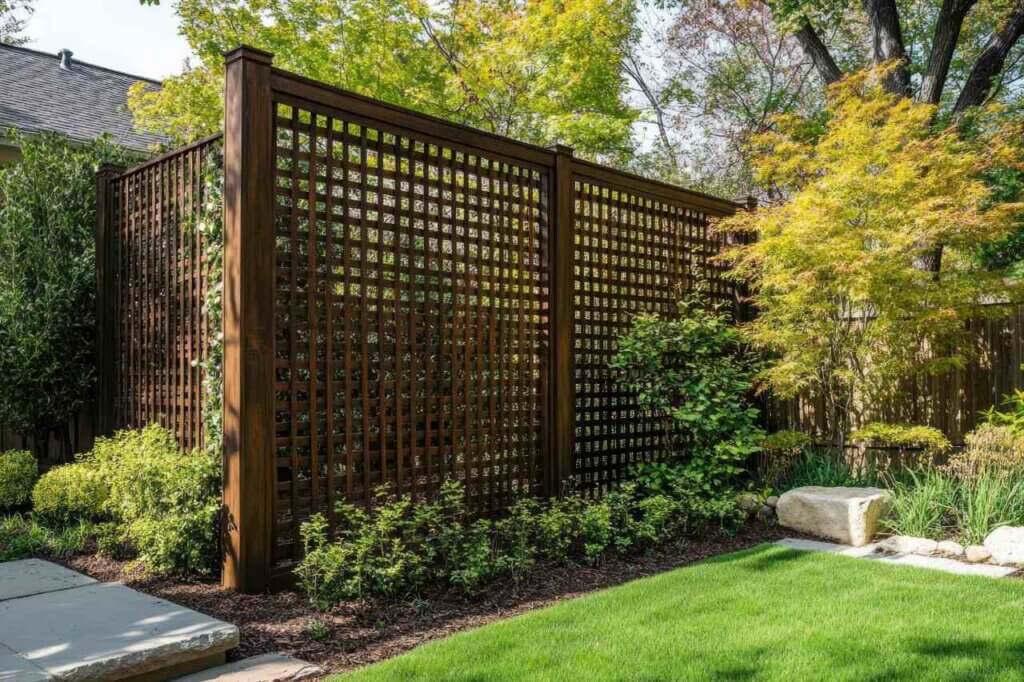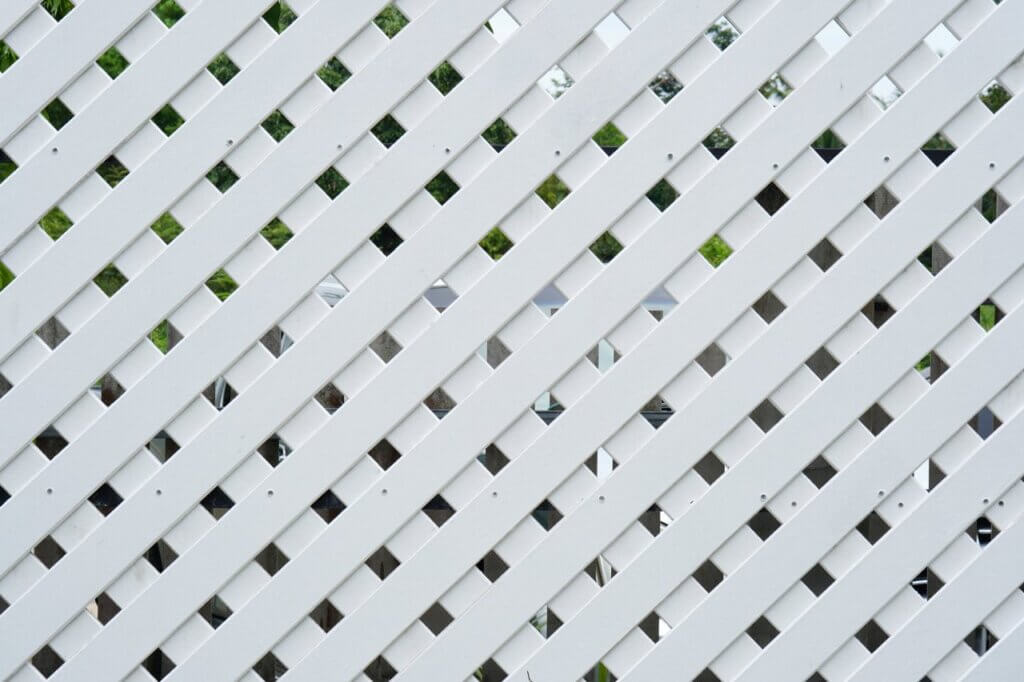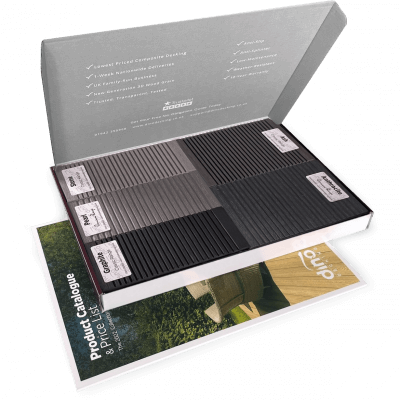5 Composite Decking Lighting Ideas
Our composite decking looks great in any setting, but you can really make your outdoor spaces shine with our decking
Products in Stock
Lowest Prices
Express Delivery
10-Year Warranty
Bank Holiday Weekend Sale. Up To 15% Off.

We’ve all been there – trying to enjoy a cuppa in the garden when you lock eyes with next door’s teenager glaring out their bedroom window. Or perhaps you’re sick of staring at that hideous trampoline the neighbours refuse to dismantle despite their kids leaving for uni three years ago.
A decent garden screen sorts these problems out nicely. But blimey, there are loads to choose from. After seeing countless garden makeovers go wrong with poor screening choices, it’s clear what actually works in British gardens and what’s just a waste of money.
Before whipping out your credit card, it’s worth thinking about what you actually need.
What’s driving you mad enough to need one?
For many people, it’s the neighbours with a talent for popping up whenever someone’s trying to sunbathe. If total privacy is your goal too, you’ll want something without gaps – those slatted ones might look fancy, but they won’t stop prying eyes.
Maybe you’re just trying to hide that neglected corner where the compost and wheelie bins live. In that case, a pretty trellis with some clematis will do the trick.
Or perhaps you’ve created a lovely seating area that gets absolutely battered by wind. Fabric screens are a complete disaster for this – first gust and they’re halfway down the street. Lesson learned: solid panels need proper anchoring in British weather.
Think about whether you want permanent screening or something you can move around. Those screens on wheels can be brilliant for repositioning depending on where the summer sun hits your patio.
Get the measuring tape out. Seriously. Too many people buy screens that are too short and still catch the neighbours peering over. Maddening.
Sit in the spots where you’ll actually be – your garden chair, the dining table, that sunny reading corner – and look around. Where exactly do you need screening? Sometimes it’s not where you initially think.
Light changes everything too. A dark screen along the south fence might look smart but can turn a herb garden into a death zone. Nothing grows. Sometimes a lighter, partially open screen works better for plant-adjacent boundaries.
Oh, and don’t feel you have to stick to straight lines. A zigzag pattern with screens can actually look far more interesting than a boring straight run, and provides better stability in windy areas too.
Let’s be honest – our weather is a nightmare for garden stuff.
That gorgeous willow screen on sale might look great in May, but come November storms, it could be compost. Garden centres are full of replacement screens every spring for good reason.
After seeing countless screens fall apart within a couple of years, it’s clear that whatever you choose needs to handle:
A proper soaking – Many parts of Britain see over 150 rainy days per year. That’s a lot of moisture for any material to handle.
Those surprise gales that come from nowhere – the type that send garden furniture flying into the neighbour’s pond. Secure anchoring isn’t optional.
Freezing winters and surprisingly hot summers – materials expand and contract. Cheap screens crack when temperatures fluctuate.
The UV even on cloudy days – budget plastic screens often last just one summer before turning brittle and an odd yellowish colour.
Having seen the successes and failures of various screening materials in British gardens, here’s what actually works:
After watching countless wooden screens warp and rot, it’s no wonder composite has become the sensible option for British gardens.
What’s good:
What’s not so good:
You can see available options for privacy screens that won’t disintegrate in our lovely British climate.
Those gorgeous laser-cut metal screens at Chelsea Flower Show have a lot to answer for – they’ve given everyone garden envy, but they’re not always practical.
What’s good:
What’s not so good:
That weathered Corten steel look is gorgeous though – developing that lovely rusty patina that actually improves with age, unlike most garden materials that just deteriorate.
Most people start with plastic because it’s cheap. There’s usually a reason for that.
What’s good:
What’s not so good:
That said, the better recycled plastic options have improved dramatically, and some have lasted in gardens for years without issues. Not all plastic screens are created equal.
These look absolutely lovely… until they don’t.
What’s good:
What’s not so good:
If you’re after that natural look, hazel hurdles tend to last longer than willow in wet areas, especially when treated with preservative every spring.
Once considered too modern for traditional homes, glass screening has become surprisingly popular in ordinary gardens across Britain.
What’s good:
What’s not so good:

The garden screen market has exploded with options, making it both exciting and bewildering to choose.
It’s tempting to choose whatever looks trendy in garden magazines, but consider your property’s character:
Modern houses with clean lines suit contemporary screens – think powder-coated aluminium or composite panels with horizontal slats. Boxy new-builds look brilliant with these.
Period properties need more sympathetic treatment. Victorian terraces look jarring with ultra-modern metal screens but sing with traditional trellis or age-appropriate ironwork.
Cottage gardens need rustic screens that blend with their informal planting – woven hazel or willow hurdles complement the jumble of cottage flowers perfectly.
Decorative screens can be stunning, but they sometimes sacrifice practicality for looks:
Intricate cut-outs create beautiful shadow patterns but provide less privacy – lovely for dividing garden zones but useless for hiding from the neighbours.
Bold geometric patterns work brilliantly in minimal gardens but can clash horribly with busy planting schemes.
Remember that patterns look completely different at scale. What seems delicately pretty in a catalogue can appear overwhelming across a full garden boundary.
For inspiration that balances beauty with function, check out creative garden screening ideas for your home from designers who understand British gardens.
Off-the-shelf screens work for many, but sometimes a garden’s quirks demand something special:
Awkward slopes might need panels cut to specific angles – many suppliers offer this service for a fee.
Unusual colours to match existing garden features often require custom ordering, especially for metal or composite screens.
Integrated features like planting pockets, shelves for lanterns, or hooks for hanging baskets make screens multi-functional.
How your screen connects to the ground affects both its stability and flexibility.
For permanent solutions, fixed screens are the business:
Concrete footings offer bombproof stability but mean serious digging and mixing. Worth the effort for exposed, windy sites.
Metal post systems strike a good balance – reasonably secure but easier to install than concrete. Perfect for most suburban gardens.
Wall-mounting brackets work brilliantly where you already have solid boundaries but need extra height for privacy.
Remember to check if you need planning permission, especially for taller screens or listed properties. The neighbours get remarkably tetchy about surprise 8-foot barriers appearing without warning.
When flexibility matters, these options let you change your mind:
Weighted base screens work well on patios and decking. They’re not completely stable in proper winds, but they won’t topple at the slightest breeze either.
Planter-based screens cleverly combine greenery with privacy – the soil adds weight while plants soften the look.
Folding screens are perfect for renters or those who need seasonal screening. They store away neatly when not needed.
Garden screens span every price point, from twenty quid to several thousand.
The cheapest bamboo screens might seem tempting, but replacing them every other year quickly makes them a false economy. That said, they’re grand for temporary needs or rented gardens.
Mid-range composite or quality wooden screens typically offer the best balance of longevity and value. Expect to pay £80-200 per metre for something that will last a decade or more.
Designer metal or glass screens command premier prices but can add genuine value to your property. If you’re planning to stay put and your garden is your sanctuary, the investment often pays off in enjoyment alone.
The perfect garden screen blends practicality with style, creating privacy without turning your garden into a fortress. Take time to consider what problems you’re actually trying to solve rather than just buying what looks pretty in the garden centre.
Remember that plants often make the best screening partners – a climbing rose softening a metal screen or bamboo planted alongside composite panels adds movement and life to rigid boundaries.
Whether you’re blocking the view of the neighbour’s hot tub or creating a cosy nook for evening drinks, the right screen transforms outdoor spaces from overlooked to oasis. Choose wisely, and you’ll wonder how you ever managed without it.

Our sample pack contains a sample piece of each colour currently available. Order your free sample pack today to compare the colours and get a true feeling of the Dino Decking range!
Our composite decking looks great in any setting, but you can really make your outdoor spaces shine with our decking
If the idea of having rats under your decking makes you shiver, don’t worry. We’ll let you know the signs
Business hours
Monday: 09:00 – 17:30
Tuesday: 09:00 – 17:30
Wednesday: 09:00 – 17:30
Thursday: 09:00 – 17:30
Friday: 09:00 – 17:30
Saturday: Closed
Sunday: Closed
Contact us
01942 355968
support@dino.co.uk
Collection Address: Unit 1 Wetheral Close Hindley Ind Estate Wigan Greater Manchester North West WN2 4HS
Pages
Products
Testing
Copyright 2025 Dino Decking Ltd All Rights Reserved.
VAT Number: GB296097848.
Company Number: 10837233.